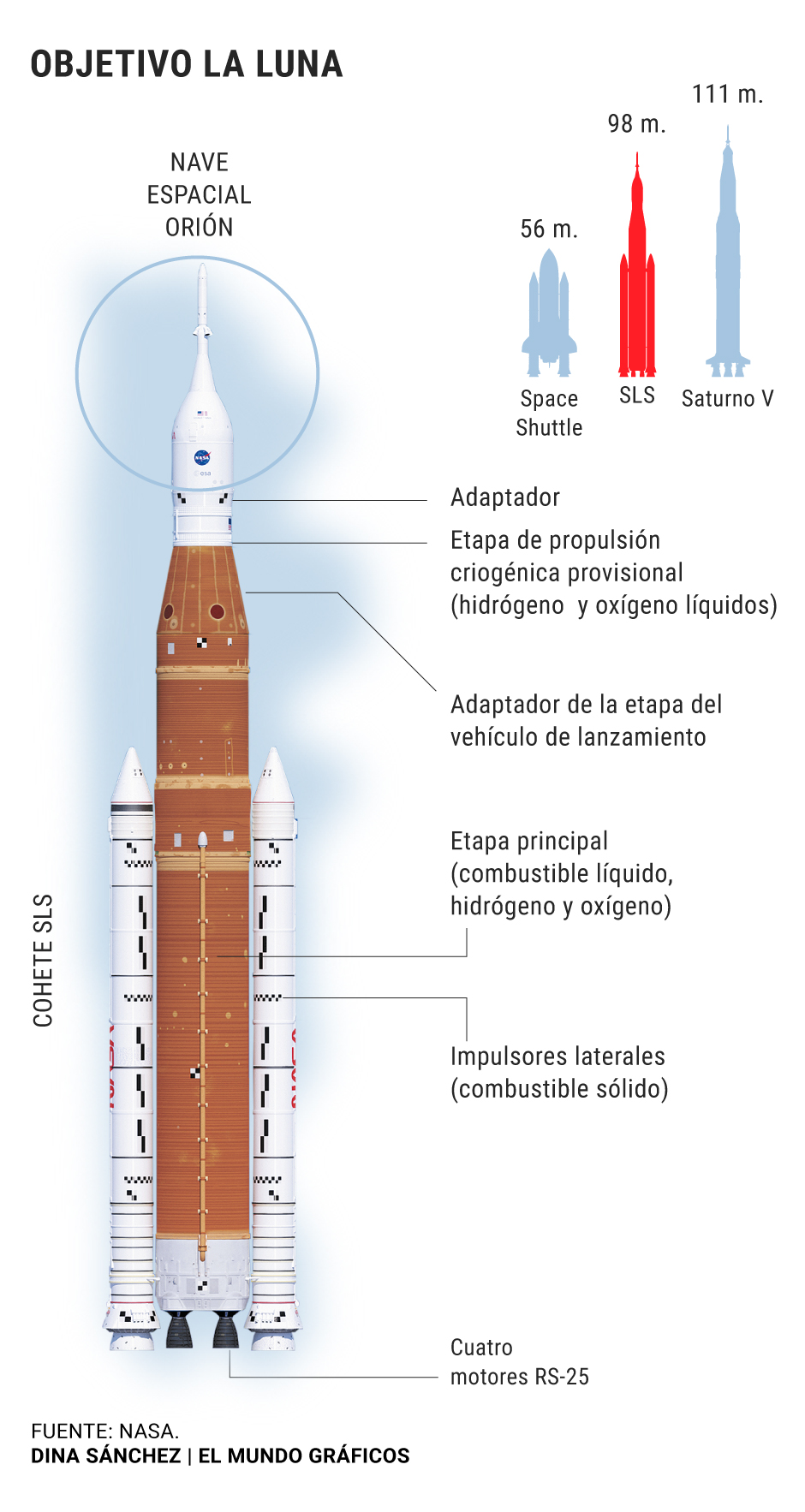Special NASA prepares to return to the Moon
NASA
does not want to wait any longer and despite the slight damage caused by Hurricane Nicole to the
Orion
spacecraft , it keeps the premiere of its
Artemis
program to return to the Moon
for tomorrow morning .
Liftoff from platform 39B of the Kennedy Space Center in Florida has been set for
7:04 a.m. on Wednesday
(Spanish peninsular time), with a launch window of two hours.
The
launch of Artemis 1
, an unmanned mission with which the US space agency will jointly test the
Space Launch System
(SLS) superrocket and the
Orion
spacecraft built to explore our satellite for the first time, has chained a series of setbacks and technical problems, including the passage of two hurricanes.
"I am optimistic and I am confident that we can carry out the launch tomorrow," said Carlos García-Galán, integration manager of the
Orion
spacecraft's European Service Module, in a telephone conversation from the Kennedy Space Center
.
The decision will be confirmed late this Tuesday afternoon because, as this Spanish NASA engineer explains, there will be a new meeting to confirm that the slight damage caused by Hurricane Nicole will not pose a risk to the mission.
"The damage has occurred where the three panels of the escape system that protect the
Orion
capsule during the first phase of launch meet. To join these panels we used a material called RTV, which is similar to silicone that is used in houses to fill joints", compares García-Galán.
"After the passage of the hurricane, it was found that one of the layers had come off and the expectation we have is that it will not go any further, but an analysis has had to be done to assess what would happen in the worst scenario, and if it could come off when the rocket reaches high speed," he explains.
Detail of the area of the ship damaged by the hurricaneNASA
Once the green light is given to the launch, he adds, they will begin to fill the rocket with fuel, for which they use liquid hydrogen and liquid oxygen.
"It's the first time we've launched the entire rocket and spacecraft system, and the first time you always discover new things
," says the engineer when asked about the setbacks suffered by the Artemis 1 mission.
The start of the program was scheduled for about a year ago, but it was postponed for several months until June.
Fuel leaks during the filling of the tanks and various incidents during the countdown test forced the launch to be delayed until August 29.
Everything was ready that day in Florida for the long-awaited launch, but a problem with a sensor in the engine thermal conditioning system forced the takeoff to be aborted: "We have learned from that mistake and have changed the procedures to make sure that it does not cause problems. "explains the engineer.
They tried again on September 3 but a hydrogen leak prevented the launch.
Then came Hurricane Ian, whose very strong winds forced the rocket and spacecraft to be stored at the end of September in the NASA hangar, the Vehicle Assembly Building VAB, where it remained for more than a month.
Artemis I. Orion Mission
The vehicle was transferred to the launch pad again on November 4, and there it has remained despite the scourge of Hurricane Nicole, since its components are designed to withstand vietnos of up to 136 kilometers per hour.
"We had to decide if we left it on the launch pad or moved it to the Assembly Building where it would have been more protected but there was also a greater risk of being affected by the storm during the journey, since it is worse that it is exposed to the wind if it It is in motion. Both options had risk and we chose to leave it fixed on the platform because there was less risk," explains García.
Carlos García-Galán, poses next to the SLS rocket at the Kennedy Space CenterC.G.
However, NASA reported that Nicole's passage caused some damage to the outer part of the
Orion
spacecraft and the launch scheduled for the 14th has been postponed until November 16.
At the moment, the weather conditions are 90% favorable for takeoff on Wednesday, but if due to a technical problem, NASA engineers decide to postpone it, the next possible dates will be November 19 and November 25.
If it leaves tomorrow, the expected duration of the mission will be 26 days, 14 of which the spacecraft will spend orbiting the Moon without actually landing.
If all goes well, the Artemis 2 mission will be launched in 2024 at the earliest, which will carry crew members and will orbit our satellite but will not land on the moon.
That will be the goal of Artemis 3, whose goal will be to land on the Moon like Apollo 11 did in 1969 and the following missions of the first and only manned program to our satellite in history so far.
At least two astronauts - a woman and a man, possibly a black man - will set foot on the Moon on a date that will not be before 2025.
Mission Artemis I. Mission
According to the criteria of The Trust Project
Know more
Graphics
POT
Articles Teresa Guerrero

